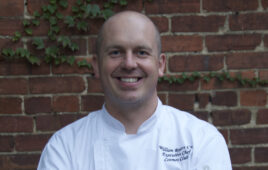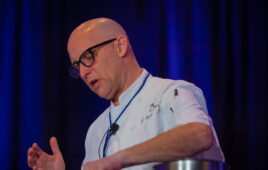Club chefs are going “whole hog” featuring lesser-known cuts of pork.
People love bacon. And with an ever-increasing number of out-there applications—bacon ice cream, bacon candy canes, and bacon bubble gum—bacon mania is here to stay.
But bacon is really only part of the whole pork picture.
As one of the most widely consumed meats in the world, pork includes everything from whole-muscle cuts like the loin and shoulder to the makings for cured products like ham and sausage. It’s an incredibly versatile protein that a growing number of club chefs are adding to menus in creative and delicious ways.
Pork for the Fork
Pork is especially popular with the members of Omaha (Neb.) Country Club, reports Executive Chef Jeff Owen, who does roughly $2.1 million in F&B annually.
“While I love using pancetta, housemade lardons and bacon to accentuate the flavor of a dish, I also enjoy featuring lesser cuts of pork,” says Owen.
Belly and boneless ribeye chops are two of his favorites.
“Each one is unique for different reasons,” he says. “I use belly to make lardons by brining it, then confiting it in pork fat—which isn’t technically a lardon, but it’s delicious nonetheless.”
He likes the boneless ribeye chop for its versatility.
“The fat content is perfect,” he says. “It works well when braised, roasted or grilled.”
He also grinds pork shoulder and butt for sausage patties, chorizo, and the club’s famous green chili pork burritos.
“These are especially great for golf outings,” he says. “They’re simple, but delicious.”
Some of Owen’s other popular pork dishes include kimchi pork tacos with Sriracha aioli, pulled pork sliders, and a seared pork ribeye over carrot crema with charred oyster mushrooms, candied pecans and a pomegranate demi-glace.
“The most important thing to remember when it comes to pork is that the method of cooking must complement the cut,” says Owen.
Mark Brown, Executive Chef of Oklahoma City Golf & Country Club (OCGCC), Nichols Hills, Okla., agrees. “When you go back to basics with pork, you get some of the best dishes,” he says.
Like Owen, Brown also likes to feature lesser-known cuts, especially hocks and trotters, jowls and spare ribs.
“We recently did a pork trio for a special event as the salad course,” he says. “We served seared pork belly, a spare-rib hushpuppy and a ham-deviled egg. At the end of the meal almost all of the members were talking about the trio.”
For hocks and trotters (as well as a number of other cuts), Brown likes to braise them, or sous vide.
“When you sous vide pork, it concentrates the flavor,” he says.
And after all, that’s the point.
“If I’m menuing a pork dish, it should taste like pork,” says Brown, who does $5.5 million in annual F&B at OCGCC.
Housemade Specialties
Brown oversees OCGCC’s charcuterie program, which produces a variety of products like sausages, kielbasa, brats, chorizo and hams for the club’s 1,100 members to enjoy.
“It’s a slow process, but we are fortunate to have a dry-aging room where we can play with different mixes,” he says.
It’s also a really great teaching tool for new chefs, he adds, noting that his team is in the process of perfecting a chorizo to “really make it our own,” he says.
Will Norem, Executive Chef at Hallbrook Country Club, Leawood, Kan., has a charcuterie program, too, where he has been known to make his own bacon, sausages, corned beef, pastrami and smoked turkey.
“Fat content is the most important thing to consider when you’re working with pork,” says Norem. “I want fatty pork chops and lean pork belly.”
“Brining is also a really great way to maintain moisture,” says Omaha CC’s Owen. “A simple but effective equilibrium brine for a few hours can add moisture, so even if the protein is ordered well-done, it has a fighting chance.”
Norem, who does $1.8 million in F&B annually at Hallbrook CC, suggests staying around 132°F for pork unless you’re braising—in which case, he says, “don’t stop until you reach 200°F.”
Profiting from Pork
Greg Myers, Executive Chef at Lancaster (Pa.) Country Club (LCC), which does $3 million in annual F&B with 650 members, changes the club’s dinner menu nightly. This gives him plenty of opportunities to feature new and different pork applications.
“I recently discovered a center-cut pork rib chop larded in a tumbler,” says Myers. “The fat is basically injected into the rib racks, making the chop tender and moist inside. It doesn’t dry out, it grills beautifully and it tastes unbelievable.”
LCC serves the larded pork rib chops for large banquets of 300 or more guests, with many of them commenting that it’s “the best pork chop they ever ate,” says Myers.
Small plates are another popular place for pork at LCC. Dishes include pork meatballs banh mi, pork carnitas tacos, and pork potstickers dim sum.
“We adjust our dishes to the seasons, too,” says Myers. “Our crackling pork ossobuco with a maple and bourbon glaze is a great fall dish. It’s cost-effective and a great use of an under-utilized cut.”
The food cost on the dish is approximately $5, but it sells for $22.
“Having these kinds of high-impact, low-food-cost items helps offset the higher-cost items like steak and seafood,” says Myers, who runs a 34% overall food cost.




